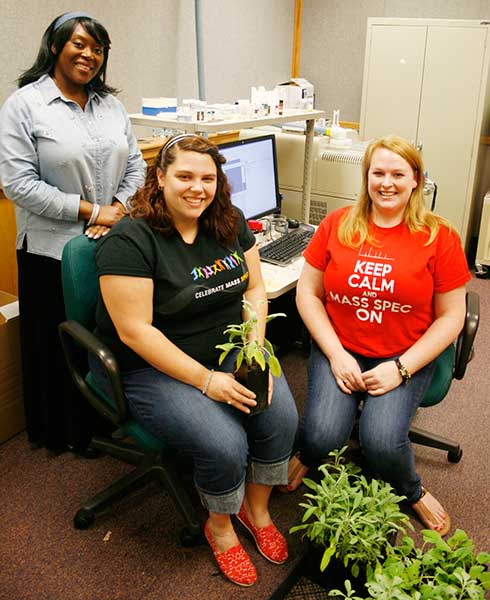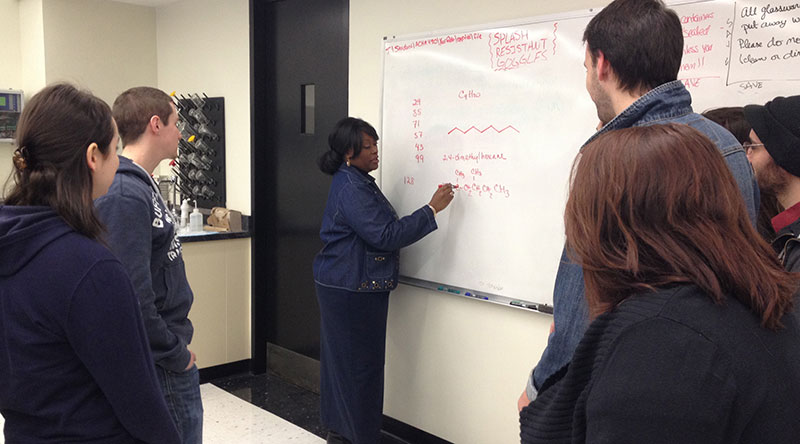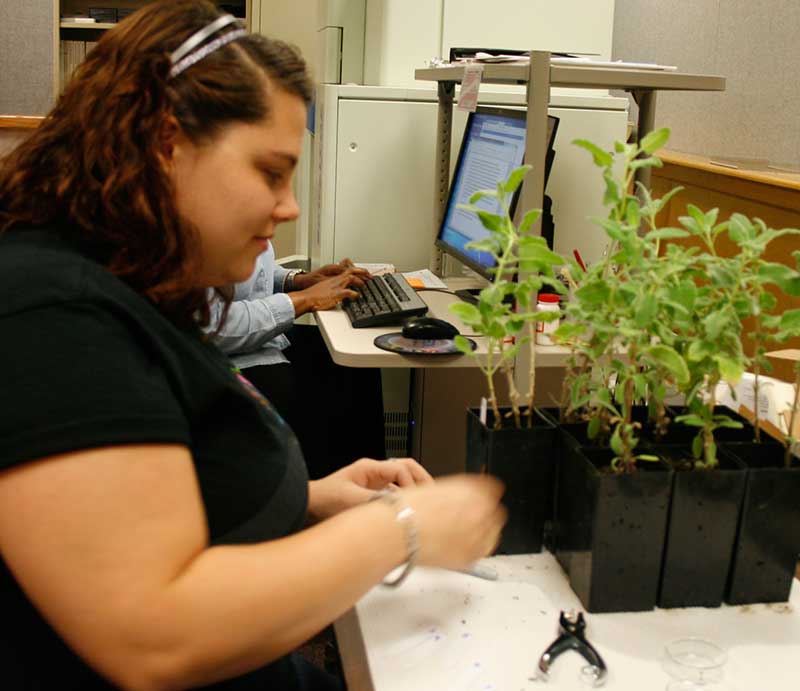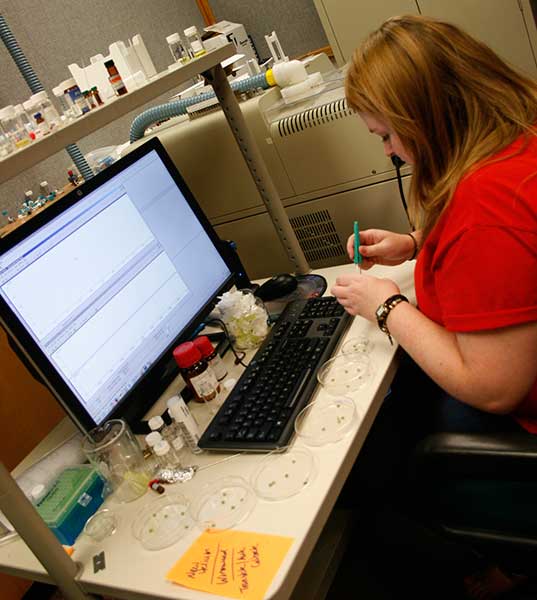University at Albany, State University of New York
Solving chemical mysteries and developing faster methods for analysis are all part of the work that goes on at the
JEOL USA Technology Centers, but it's not only by JEOL scientists. Since the development of Direct Analysis in Real Time (DART™) technology for the company's AccuTOF time-of-flight mass spectrometer, the lab has helped researchers analyze samples from forensics to food using this novel technique that instantly detects the small molecule components of virtually anything waved in front of it.
 University at Albany, State University of New YorkCategory
University at Albany, State University of New YorkCategoryProfessor Rabi Musah with Ph.D. candidates
 University at Albany, State University of New YorkCategory
University at Albany, State University of New YorkCategoryProf. Rabi Musah in her classroom at SUNY
For a week in July 2014, the JEOL Technology Center near Boston, MA, resembled a greenhouse.
Professor Rabi Musah and two Ph.D. students from the
University at Albany, State University of New York, visited JEOL to use the AccuTOF-DART mass spectrometer as part of a National Science Foundation (NSF)-funded study of the environmental impact of plant small molecule emissions. They arrived with two carloads of homegrown potted plants including
Eucalyptus,
Salvia, and
Mimosa species. Both Ph.D. candidates methodically conducted their separate experiments, punching out samples from the leaves and analyzing each in turn by waving a tweezer-gripped specimen in front of the DART. One student was looking at the chemical profiles of the plants for a forensics database, while the other was working on developing DART as a tool to study the kinetics of plant emissions.
"It's usually difficult and time-consuming to do this kind of characterization," explained Professor Rabi Musah as the two students recorded the mass spectra that quickly appeared on the monitor. "What they accomplished in one day would take about two years by traditional methods." Prof. Musah's lab has a conventional GC Mass Spec and she recently received NSF support for the acquisition of an AccuTOF-DART to complement the analytical capabilities at SUNY.
Briefly describing the NSF Grant, "Plant-derived Biogenic Sulfur Emissions and the Environment," Professor Musah said, "We are looking at molecules that plants produce and their environmental impact. We've been working on this for one year only, and in that time we have discovered that plants from the Mimosa family produce a variety of sulfur compounds from the root system into the environment and we can monitor these in real time. No one expected that the roots would produce volatile molecules that enter into the atmosphere from the soil. Currently, when we think of sulfur-based environmental pollutants, we most often consider those that are anthropogenic, or a result of human activity. Very little information is available on the contributions that plants make to the atmospheric sulfur. Our studies will broaden the scope of what is known."
It turns out that the results of the grant's work have ramifications for a number of different fields, including agriculture, medicinal chemistry and forensics. For example, the methodology developed to characterize emissions of molecules into the atmosphere can also be applied to observe molecules released from plants that are abused for their psychotropic effects.
Ph.D. candidate Ashton Lesiak's work is focused on profiling what are known as “legal alternatives” to plants that are abused for their psychotropic effects. Ultimately she foresees a database and reference guide that will help forensic scientists quickly confirm the presence of such plants, she said. "When plants of abuse are found at a crime scene they are usually ground up or dried. The usual way to determine what the plants are is to look for characteristic morphological features by microscopy. When the plant is dried or ground, it loses its characteristic morphological features and microscopy becomes less useful in identifying the plant. However, if you analyze the material directly using DART MS, its chemical profile will be revealed and this can be used to identify the plant. For example you easily can detect THC in marijuana, atropine and scopolamine in Datura seeds, and mitragynine in Kratom. Detecting these small molecule biomarkers helps in identifying unknown plant material.”
The technique is "cooler than the traditional way of doing things, and compared to the way we conducted analyses before it feels like magic—Justine can literally use a hole puncher to get a leaf sample and hand to Ashton who analyzes it by DART-MS to get its small molecule profile," says Musah. ”In the more conventional approach, samples would first need to be extracted using a solvent, then concentrated, and then analyzed. In most cases, a comprehensive profile could not be obtained in a single experiment because the types of molecules seen depended on the solvent system used. The conventional method can also be quite time consuming”.
 University at Albany, State University of New YorkCategory
University at Albany, State University of New YorkCategoryPh.D. candidate Justine Giffen is pursuing methods for observing real-time chemistry in living systems by monitoring the kinetics of formation of the molecules emitted by plants.
 University at Albany, State University of New YorkCategory
University at Albany, State University of New YorkCategoryPh.D. candidate Ashton Lesiak's work is focused on profiling what are known as “legal alternatives” to plants that are abused for their psychotropic effects.
Ph.D. candidate Justine Giffen is pursuing methods for observing real-time chemistry in living systems by monitoring the kinetics of formation of the molecules emitted by plants, and then following the kinetics of the reactions that occur when these molecules are exposed to environmentally relevant free radicals. The development of this approach has applications in a number of research areas including those involving the study of mammalian systems. For example, currently it is quite difficult to determine the identity of biomarkers that are indicative of the presence of a disease state. The DART technique could be used to develop methods to monitor the kinetics of biological reactions and follow biological chemistry in real time.
JEOL's Mass Spectrometry Product Manager and co-inventor of the DART, Dr. Chip Cody, continues to develop new techniques and applications for the AccuTOF-DART, and working with researchers outside the company has led to some fascinating projects outside the realm of the traditional demonstration lab.